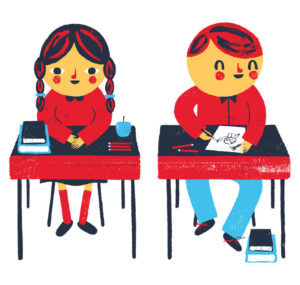Preparing Yourself to Conduct a Sexuality Education Class in School
Tips on Designing The Content
Teach Age-Appropriate Information:
Topics should be tailored according to the age of the students.
Early elementary school students need to learn the proper names for their body parts, the difference between kinds of touches, the concept of personal space and boundaries along with ways in which they can be a good friend (the foundation for healthy intimate relationships later in life).
Fourth- and fifth-graders need information about puberty and their changing bodies, Internet safety, and the harmful impact of bullying.
And seventh-, eighth- and ninth-graders are ready for information about body image, reproduction, contraception, H.I.V. and disease prevention, communication, and the topic they most want to learn about: healthy relationships.
All young people need to know about puberty — preferably before it happens. However, the manner in which it is taught may be very different and tailored to the needs of the group. Non-disabled youth may easily orient themselves to a chart of the internal human reproductive organs. Youth with disabilities may need more time in order to make sense of this type of visual aid, or they may not find them useful at all.
Be Prepared:
Have thorough command of the subject matter before attempting to have a conversation around the topic. Get all the information you can before introducing the topic to students. Also think about what approaches work well with the particular group of children you are addressing. Or if there are any sexuality issues or topics that would be of particular interest to them. Has the group ever had any sexuality education? If so, find out what was covered? Why is the group requesting a workshop at this time? This will also help you establish a baseline.
Teach Sexuality as Positive and Pleasurable:
Adopting a fear based approach that only talks about children as potential victims cause undue anxiety in students. Instead ensure the tone is empowering and affirming.
For example, a child who asks, “Why do I have a penis?” might be wondering about why touching it feels good, or why their body looks different from their sister’s, or what part the penis plays in reproduction. To figure out what they’re really asking you can say, “That’s a great question, what made you think of that? Or Can you tell me what you already know about that?” or “What do you think the answer is?”
Remember to keep your answers simple; For example if a four-year-old finds a condom and ask what it is, the answer could be “It’s a condom” that will satisfy many children. If they follow it up with, “What’s it for?” you can elaborate slightly: “When people don’t want more babies; condoms help them do that.” You don’t have to give explicit detail unless you want to have a longer discussion.
Make The Classroom A Safe Space:
Initiating the talk about body parts and sexuality in your classroom can seem challenging. There is a chance that both you and your students feel awkward as you begin to discuss the issues. You must realize that this is the first time that many of your students will be discussing these subjects in a ‘public space.
As a teacher, you first need to facilitate the creation of the emotional and social climate of safety that makes your classroom a place where students can speak out, express their views, discuss, debate without being singled out, judged or embarrassed.
You may do this by working with the students to help frame ground rules in your classroom that everyone agrees to adhere to.
Involve the students in making a list of rules. Some examples you can use as a guide are:
- respect each other
- no personal questions or remarks
- questions are welcome
- use correct terms
- listen when others are speaking
- classroom discussions are confidential, what is discussed in the classroom stays in there
- it is okay to make mistakes
- don’t judge each other based on your opinions
- speak for yourself
- respect personal boundaries
- we will be sensitive to diversity, and be careful about making careless remarks
- it’s okay to have fun
Once you have framed the ground rules:
- Explain them clearly so that students are very clear about what’s expected.
- Make a poster of the agreed upon ground rules & stick them in your classroom.
Tips on Delivering the Sessions
Use Visual Aids:
Use realistic photos or full body charts. Photos of the youth’s family members and friends can form the basis for a discussion on the different types of relationships and how one acts in each of these relationships. Pictures cut from magazines can serve a variety of purposes. Full body charts can be purchased or made by tracing the outline of each youth on a large piece of newsprint roll. Each chart can be personalized according to the students’ wishes. Body charts are one concrete way to show where body parts are and what they do. Some groups make these body charts as their first activity and then refer to them throughout the semester or year as each health topic is covered. Browse the Aarambh India Videos & Posters Pages for Free Resources That You can Use.
Repeat Key Information:
Repeat key information frequently. To check for understanding, ask the group for feedback. Reinforce important concepts throughout several lessons. Small amounts of information spaced out over time work best. Use opportunities to repeat key ideas in other curriculum areas where appropriate. Group activities & Quiz Competitions can help reinforce key concepts.
Provide Practice Opportunities
Provide opportunities for youth to practice skills. Role play is an excellent technique. Have youth rehearse how to greet a new acquaintance, how to ask someone out on a date, etc. These practice sessions can even be recorded and viewed again by the group for constructive comment. To reinforce appropriate behavior, be sure to use scenes in which the role players were successful.
Use Many Approaches
People learn in many different ways. Recognize that no one approach is best. Use a variety of methods to teach concepts. Ideally, use activities that involve verbal discussion, movement, signs, colors and icons (such as a green light for “okay” and red light for “stop”). Draw upon as many of the senses as possible. Also remember to evaluate your efforts. What methods worked well? Which ones bombed? Why? Experiment, be creative, and learn from successes and mistakes.
Use Humor
Strive to make sexuality education as ordinary and matter-of-fact as other subjects. A sense of humor is key. Laugh with the children, learn as you teach.
Keep Up-to-Date on New Resources
Research sources of further information regularly. Check the Internet, visit the library, keep current on the latest strategies and materials. There are books and videos on this topic, with new resources available at ever increasing rates. Click here to sign up for the Aarambh India newsletter to receive updates in your inbox.
(source:ReCAPP,Teaching Sexual Health, New York Times,Planned Parenthood, A Mighty Girl) (image source: Ben Javens)








